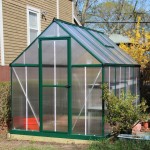
My brother-in-law and I put this together over a long afternoon. Much of that time was spent building and leveling a 4×4 frame – the actual construction went pretty smoothly.
On the other hand…
It stayed intact for about 24 hours. The very next day, a typical springtime storm rolled through with a bit of wind (the weather report claimed 30mph gusts). When I got home from work, the door side of the greenhouse was crumpled in, some of the horizontal supports bent backwards on themselves and a few twinwall panels were blowing around the yard.
The window panels are standard-ish, 4mm polycarbonate twinwall (mostly 2ft x 4ft? sections) and can be sourced easily online, but the metal structural parts are custom and replacement parts can’t be bought separately – so wrecking any is a big deal!
Anti-Flex / Anti-Fall-Apart-In-A-Stiff-Wind Fixes
This revealed the main apparent design flaw: Many of the structural components are joined together by nothing more than the friction of a bolt head – not even passed through complete holes in both parts (which would somewhat fix the parts together even if the bolt were to loosen), but often via a U-shaped notch in one or both parts, or with the bolt sliding freely in a t-slot. Major places this appears to be a problem are:
- where the vertical rails for the walls slot into the base
- where the upper and lower halves join together at the ends (mainly the upper bolts in the horizontal metal supports about halfway up either end)
- where the verticals around the door bolt into the horizontal near the ceiling
Add to this the fact that many of these end bolts must be tightened only after installing the twinwall panels, which renders the heads nearly inaccessible, and flimsy cross-bracing (more on that later), and you end up with a major structural problem. Each time a gust of wind hits, the top of the greenhouse can sway back and forth a bit with respect to the base (the diagonal support straps simply flex). Each time this happens is an opportunity for these friction-held bolts to very slightly work themselves apart. Enough cycles of this (a day’s worth, depending on the day) are enough to separate the vertical wall rails from the base, or the bolted notches at the above-indicated spots from one another.
If you live in a breezy location, one of the best favors you can do for yourself is scrap these flimsy diagonal straps on either end in favor of some sturdy aluminum angle or U-channel stock from your nearest hardware store. One catch, I’ve only seen such stock for sale in the US in 4-ft and 8-ft lengths, while the pieces for the greenhouse are 51″. So to do it proper you’d have to get 8ft pieces and have nearly half of each piece as scrap. Not a huge problem if you have other uses for this material, but otherwise it’s annoying. Since the lower bolt each one mates to is in a slot in the greenhouse’s vertical rails and can slide freely, you can maybe cheat and use 4-ft lengths by not having them go all the way to the bottom. Probably still better than the straps it came with.
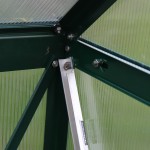
In addition, I found the following small tweaks very helpful in keeping the thing together:
- Ditch that silly tube-thing that comes with the greenhouse and is supposed to act as a nut driver. Use a proper nut driver. You just can’t torque them down tight enough with that tube-thing.
- Wherever those U-shaped notches occur on the endwall pieces, replace the standard nut with a locknut and (on the head side) lockwasher. The square-headed bolts that come with the greenhouse appear to be 1/4″, but with a non-standard thread pitch (non-standard = not what the Home Depot sells). So you may as well replace the bolt too (these end ones don’t require the square heads for anything) – preferably with the widest head you can find. Locknuts tend to have a wide flange around them…and, well, be locking. This should help them get a better grip on those U-shaped notchy bits.
- Find, buy or fashion some thin tool you can slip between the horizontal supports and the twinwall panels to hold the bolt heads in place while you torque them down. I got extremely lucky and found a thin stamped-metal “crescent wrench” (from some Ikea furniture, I think) lying around that was a perfect fit, that I could slip in and juuust grab the edge of those square-headed bolts. You can probably fashion something using a hacksaw and any thin piece of metal (like one of those useless diagonal straps).
One final comment on this. After it blew apart the first time and things shifted a bit, I discovered the vertical members on either side of the door were now “too short” (or the ceiling assembly “too tall”) for the two to bolt together reliably anymore. On further inspection, the stamped metal base on this side seems to have “sagged”, so when the vertical wall supports were bolted to it, they no longer adequately reached the part it’s supposed to bolt to. Of course, anyone stepping or even brushing their feet against the base on the way in/out will just make this worse. To remedy, I cut some braces out of some aluminum stock I had handy and wedged them under the lip to prop it up at the edges of the doorframe.
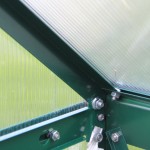
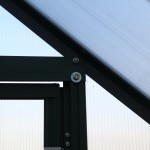
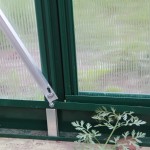
Spare Parts
After completing assembly, I found I had at least a half-dozen square-headed bolts left over. The instructions make oblique reference to there being spares of some parts, but if I had known I’d have this many, I’d have dropped the extras down the vertical wall supports to provide extra attachment points. This could be handy to double-up the cross-brace straps along the sidewalls (if you followed the very strong recommendation above, you should have 4 spare ones now), or provide a way to hang small tools, etc.
More Windproofing
The doorhandle is pretty loose and can be easily lifted by the wind, letting the door fly open and thrash itself and everything it touches into oblivion. If you bought the accessory plant-hanging hooks (little plastic doohickies that twist-lock into the t-slots along the walls and ceiling), you can insert one on the inside of the door behind the handle, providing a convenient place to hook a spring or rubber band to maintain some downward tension on the handle.
Online reviews for a cheaper greenhouse from another vendor (sounds like ‘Hazard Fraught‘) recommend caulking in the twinwall panels to prevent them being popped out by the wind. I haven’t done this yet, but plan to.
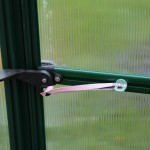
Leave a Reply